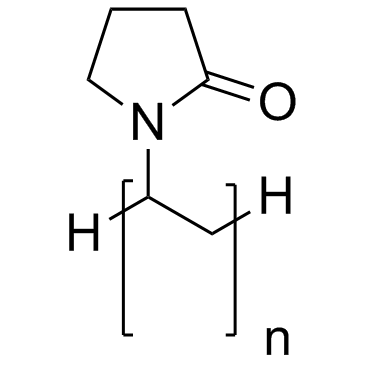Polyvinylpyrrolidone

Polyvinylpyrrolidone structure
|
Common Name | Polyvinylpyrrolidone | ||
|---|---|---|---|---|
| CAS Number | 9003-39-8 | Molecular Weight | 111.1418 (monomer) | |
| Density | 1.144g/cm3 | Boiling Point | 217.6ºC at 760 mmHg | |
| Molecular Formula | (C6H9NO)n | Melting Point | 130ºC | |
| MSDS | Chinese USA | Flash Point | 93.9ºC | |
Use of PolyvinylpyrrolidonePolyvinylpyrrolidone is a compound which has been widely tested and used in human and veterinary medicine as an effective wound healing accelerator and disinfectant when combined with iodine and other compounds. |
| Name | poly(vinylpyrrolidone) |
|---|---|
| Synonym | More Synonyms |
| Description | Polyvinylpyrrolidone is a compound which has been widely tested and used in human and veterinary medicine as an effective wound healing accelerator and disinfectant when combined with iodine and other compounds. |
|---|---|
| Related Catalog | |
| In Vivo | Goldfishes which are treated with salt have significantly lower mucus weights at 25 h. Goldfishes treated with Polyvinylpyrrolidone (PVP) have significantly higher mucus weights at 25 h. Koi treated with salt and Polyvinylpyrrolidone (PVP) has significantly lower mucus weight at 1 and 25 h. Control koi has significantly higher mucus at 25 h. At the end of 2 weeks, it is determined that the three koi treated with salt and Polyvinylpyrrolidone(PVP) remain healthy and show a higher degree of healing than other treatment koi and the control group[1]. |
| Animal Admin | Each fish within a tank serves as a replicate. Treatments are designated as Polyvinylpyrrolidone (at a dose of 10 mL/10 gallon) and saline/salt at 3g/L. A control group that does not receive any chemical is also included in the study. All fishes from each treatment group are sampled at 0 min, 15 min, 1 h, 4 h and 25 h. At each time interval, all fishes from each treatment group are anaesthetized using buffered tricaine methanesulfonate, weighed, and slime is scraped from one 1 cm2 area over the epaxial musculature using a preweighed plastic coverslip[1]. |
| References |
| Density | 1.144g/cm3 |
|---|---|
| Boiling Point | 217.6ºC at 760 mmHg |
| Melting Point | 130ºC |
| Molecular Formula | (C6H9NO)n |
| Molecular Weight | 111.1418 (monomer) |
| Flash Point | 93.9ºC |
| PSA | 20.31000 |
| LogP | 0.69020 |
| Storage condition | Store at RT. |
| Water Solubility | H2O: soluble100mg/mL |
CHEMICAL IDENTIFICATION
HEALTH HAZARD DATAACUTE TOXICITY DATA
|
|
~% 
Polyvinylpyrrolidone CAS#:9003-39-8 |
| Literature: US2006/216263 A1, ; Page/Page column 5-6 ; |
| Precursor 1 | |
|---|---|
| DownStream 0 | |
| HS Code | 3905990000 |
|---|
|
Solution growth of spherulitic rod and platelet calcium phosphate assemblies through polymer-assisted mesoscopic transformations.
Mater. Sci. Eng. C. Mater. Biol. Appl. 33(4) , 2175-91, (2013) Solution growth of apatite its precursors in the presence of urea commercial gelatin is found to lead, under appropriate conditions, to a rich spectrum of morphologies, among them high aspect ratio ne... |
|
|
Curcumin amorphous solid dispersions: the influence of intra and intermolecular bonding on physical stability.
Pharm. Dev. Technol. 19(8) , 976-86, (2014) We have investigated the physical stability of amorphous curcumin dispersions and the role of curcumin-polymer intermolecular interactions in delaying crystallization. Curcumin is an interesting model... |
|
|
Formulation and evaluation of clozapine orally disintegrating tablets prepared by direct compression.
Pharmazie 68(2) , 110-6, (2013) Identifying signaling pathways that regulate hematopoietic stem and progenitor cell (HSPC) formation in the embryo will guide efforts to produce and expand HSPCs ex vivo. Here we show that sterile ton... |
| k60 |
| Polyvinylpyrrolidone |
| PVP |
| Kollidon K25 |
| Kollidon K-90 |
| k25 |
| MFCD00149016 |
| POP |
| Kollidon 25 |
| k115 |
| pvp2 |
| pvp3 |
| K-30 |
| pvp4 |
| PVPD |


